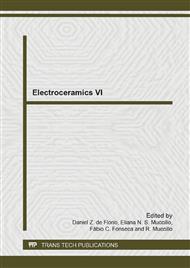p.101
p.106
p.111
p.116
p.122
p.128
p.137
p.143
p.149
Ferromagnetic Cluster on La2FeMnO6
Abstract:
The structural, magnetic and electrical transport properties of La2MnFeO6 bulk samples prepared by combustion synthesis have been investigated. The X-ray powder diffraction (XRD) patterns with Rietveld refinement at room temperature shows that samples prepared by combustion synthesis are formed in single phase with an orthorhombic structure space group Pnma (62). The temperature dependent magnetization shows a formation of ferromagnetic cluster at 150K with short range interactions and a long range ferromagnetic order below 75 K. The magnetic field dependence of the magnetization shows a typical paramagnetic behavior at room temperature and a ferromagnetic-like behavior at low temperatures. The low value of the magnetization at high magnetic field can indicate the formation of a weak ferromagnetism or a metamagnetic phase. Results of the temperature dependence of the resistivity show that the transport process in this material can be attributed to small polarons.
Info:
Periodical:
Pages:
122-127
Citation:
Online since:
July 2014
Authors:
Price:
Сopyright:
© 2014 Trans Tech Publications Ltd. All Rights Reserved
Share:
Citation:


